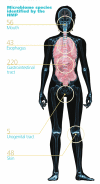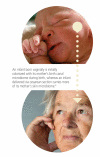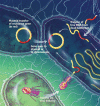A study in balance: how microbiomes are changing the shape of environmental health
- PMID: 21807598
- PMCID: PMC3237378
- DOI: 10.1289/ehp.119-a340
A study in balance: how microbiomes are changing the shape of environmental health
Figures





Similar articles
-
Conserved rhodolith microbiomes across environmental gradients of the Great Amazon Reef.Sci Total Environ. 2021 Mar 15;760:143411. doi: 10.1016/j.scitotenv.2020.143411. Epub 2020 Nov 7. Sci Total Environ. 2021. PMID: 33243513
-
Computational prediction of CRISPR cassettes in gut metagenome samples from Chinese type-2 diabetic patients and healthy controls.BMC Syst Biol. 2016 Jan 11;10 Suppl 1(Suppl 1):5. doi: 10.1186/s12918-015-0248-x. BMC Syst Biol. 2016. PMID: 26818725 Free PMC article.
-
Comparative genome-centric analysis reveals seasonal variation in the function of coral reef microbiomes.ISME J. 2020 Jun;14(6):1435-1450. doi: 10.1038/s41396-020-0622-6. Epub 2020 Mar 2. ISME J. 2020. PMID: 32123297 Free PMC article.
-
Causes and consequences of biotic interactions within microbiomes.Curr Opin Microbiol. 2019 Aug;50:35-41. doi: 10.1016/j.mib.2019.09.004. Epub 2019 Oct 16. Curr Opin Microbiol. 2019. PMID: 31627129 Review.
-
Metagenomic approaches: effective tools for monitoring the structure and functionality of microbiomes in anaerobic digestion systems.Appl Microbiol Biotechnol. 2019 Dec;103(23-24):9379-9390. doi: 10.1007/s00253-019-10052-5. Epub 2019 Nov 9. Appl Microbiol Biotechnol. 2019. PMID: 31420693 Review.
Cited by
-
Short-Term Exposure to Coal Combustion Waste Has Little Impact on the Skin Microbiome of Adult Spring Peepers (Pseudacris crucifer).Appl Environ Microbiol. 2016 May 31;82(12):3493-3502. doi: 10.1128/AEM.00045-16. Print 2016 Jun 15. Appl Environ Microbiol. 2016. PMID: 27037118 Free PMC article.
-
Nutrient-toxic element mixtures and the early postnatal gut microbiome in a United States longitudinal birth cohort.Environ Int. 2020 May;138:105613. doi: 10.1016/j.envint.2020.105613. Epub 2020 Mar 3. Environ Int. 2020. PMID: 32142916 Free PMC article.
-
Perinatal Lead Exposure Alters Gut Microbiota Composition and Results in Sex-specific Bodyweight Increases in Adult Mice.Toxicol Sci. 2016 Jun;151(2):324-33. doi: 10.1093/toxsci/kfw046. Epub 2016 Mar 8. Toxicol Sci. 2016. PMID: 26962054 Free PMC article.
-
The nasal and oropharyngeal microbiomes of healthy livestock workers.PLoS One. 2019 Mar 12;14(3):e0212949. doi: 10.1371/journal.pone.0212949. eCollection 2019. PLoS One. 2019. PMID: 30861031 Free PMC article.
-
Metagenomics, Metatranscriptomics, and Metabolomics Approaches for Microbiome Analysis.Evol Bioinform Online. 2016 May 12;12(Suppl 1):5-16. doi: 10.4137/EBO.S36436. eCollection 2016. Evol Bioinform Online. 2016. PMID: 27199545 Free PMC article. Review.
References
-
- NAS. Interplay of the Microbiome, Environmental Stressors, and Human Health [workshop], 27–28 April 2011, Washington, DC. Washington, DC:National Academies of Sciences (2011). Available: http://tinyurl.com/4xotab3 [accessed 19 Jul 2011]
-
- Dominguez-Bello MG, et al. Delivery mode shapes the acquisition and structure of the initial microbiota across multiple body habitats in newborns. Proc Natl Acad Sci USA. 2010;107(26):11971–11975. http://dx.doi.org/10.1073/pnas.1002601107 - DOI - PMC - PubMed
-
- Claesson MJ, et al. Composition, variability, and temporal stability of the intestinal microbiota of the elderly. Proc Natl Acad Sci USA. 2010;108(suppl 1):4586–4591. http://dx.doi.org/10.1073/pnas.1000097107 - DOI - PMC - PubMed
-
- Dethlefsen L, et al. The pervasive effects of an antibiotic on the human gut microbiota, as revealed by deep 16S rRNA sequencing. PLoS Biology. 2008;6(11):e280. http://dx.doi.org/10.1371/journal.pbio.0060280 - DOI - PMC - PubMed
-
- Castagnini C, et al. Reduction of colonic inflammation in HLA-B27 transgenic rats by feeding Marie Ménard apples, rich in polyphenols. Br J Nur. 2009;102(11):1620–1628. http://dx.doi.org/10.1017/S0007114509990936 - DOI - PubMed
Publication types
MeSH terms
LinkOut - more resources
Full Text Sources
Medical

